浙江财经大学企业金融期末复习资料
最新浙江财经大学国际金融期末复习

第一章一、名词解释1、国际收支:一国居民在一定时期内与外国居民之间的全部经济交易的系统记录。
2、国际收支平衡表:系统地纪录一国某一特定时期(一般为一年)内各种国际收支项目及其金额的一种统计报表,它集中反映该国国际收支的构成和总貌。
3、经常账户:指对实际资源在国际间的流动行为进行记录的账户,包括货物、服务、收入和经常转移。
4、离岸价(FOB):即装运港船上交货价,是指卖方在约定的装运港将货物交到买方指定的船上。
5、到岸价(CIF):也称为成本加运保费(指定目的港)条款。
是指卖方除负有在CFR条款下的同样义务外,还必须就运输中买方负担的货物灭失或损坏的风险对货物保险。
6、自主性交易:指个人和企业为某种自主性目的(自身利益)而从事的交易。
二、思考题1、国际收支平衡表编制的原则是什么?(1)按复式记账法记账,即每笔交易都由两笔数值相等方向相反的账目表示。
借方记:本国商品劳务进口支出、对外资产的增加、对外负债的减少;贷方记:本国商品劳务出口收入、对外资产的减少、对外负债的增加。
(2)采用权责发生制,即经济交易发生的时间或记录日期的确定以所有权发生转移时确认。
(3)进出口的计价以离岸价记2、国际收支失衡的衡量标准和口径是什么?衡量一国国际收支是否平衡主要看自主性交易是否平衡。
(1)贸易收支差额:出口大于进口时为贸易顺差,反之为逆差(2)经常项目收支差额(3)基本账户差额(4)综合账户差额3、国际收支平衡表各帐户间有什么联系?(1)各账户间是一种平衡关系。
经常账户的差额+资本和金融账户的差额+错误和遗漏账户的差额=0(2)如果划一条线,把国际收支平衡表区分为两个部分,其线上所有项目差额的合计必然等于线下所有项目差额合计的相反数。
(3)一笔交易可能同时涉及多个账户4、国际收支失衡原因分析。
1)临时性不平衡。
是指由临时性因素引起的国际收支不平衡。
这些临时性的因素有季节性因素、自然灾害、突发性疾病流行和政治动荡等。
浙江财经大学金融学期末题库
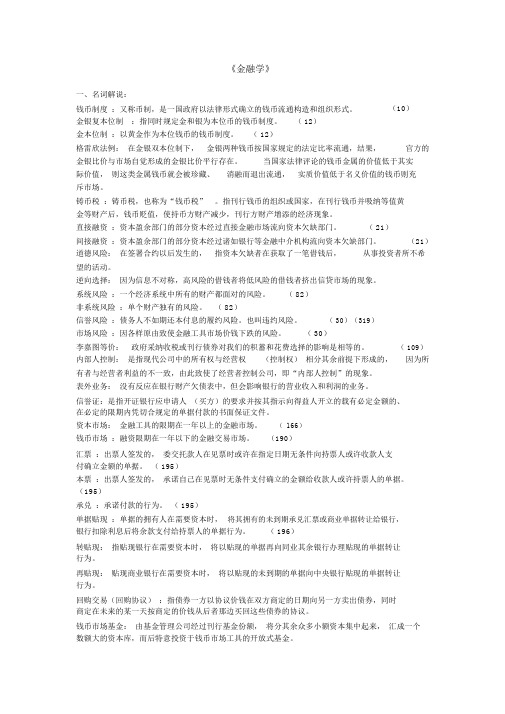
《金融学》一、名词解说:钱币制度:又称币制,是一国政府以法律形式确立的钱币流通构造和组织形式。
(10)金银复本位制:指同时规定金和银为本位币的钱币制度。
( 12)金本位制:以黄金作为本位钱币的钱币制度。
( 12)格雷欣法例:在金银双本位制下,金银两种钱币按国家规定的法定比率流通,结果,官方的金银比价与市场自觉形成的金银比价平行存在。
当国家法律评论的钱币金属的价值低于其实际价值,则这类金属钱币就会被珍藏、消融而退出流通,实质价值低于名义价值的钱币则充斥市场。
铸币税:铸币税,也称为“钱币税” 。
指刊行钱币的组织或国家,在刊行钱币并吸纳等值黄金等财产后,钱币贬值,使持币方财产减少,刊行方财产增添的经济现象。
直接融资:资本盈余部门的部分资本经过直接金融市场流向资本欠缺部门。
( 21)间接融资:资本盈余部门的部分资本经过诸如银行等金融中介机构流向资本欠缺部门。
(21)道德风险:在签署合约以后发生的,指资本欠缺者在获取了一笔借钱后,从事投资者所不希望的活动。
逆向选择:因为信息不对称,高风险的借钱者将低风险的借钱者挤出信贷市场的现象。
系统风险:一个经济系统中所有的财产都面对的风险。
( 82)非系统风险:单个财产独有的风险。
( 82)信誉风险:债务人不如期还本付息的履约风险。
也叫违约风险。
( 30)(319)市场风险:因各样原由致使金融工具市场价钱下跌的风险。
( 30)李嘉图等价:政府采纳收税或刊行债券对我们的积蓄和花费选择的影响是相等的。
( 109)内部人控制:是指现代公司中的所有权与经营权(控制权)相分其余前提下形成的,因为所有者与经营者利益的不一致,由此致使了经营者控制公司,即“内部人控制”的现象。
表外业务:没有反应在银行财产欠债表中,但会影响银行的营业收入和利润的业务。
信誉证:是指开证银行应申请人(买方)的要求并按其指示向得益人开立的载有必定金额的、在必定的限期内凭切合规定的单据付款的书面保证文件。
资本市场:金融工具的限期在一年以上的金融市场。
浙江财经金融专硕-公司金融习题集公司金融案例 期末2
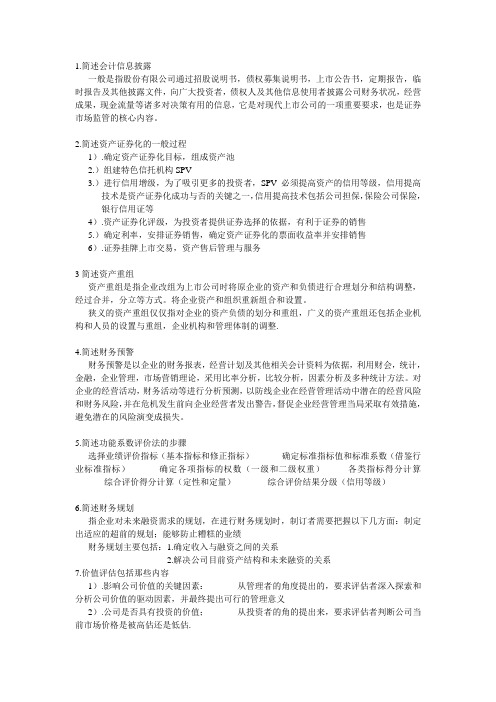
1.简述会计信息披露一般是指股份有限公司通过招股说明书,债权募集说明书,上市公告书,定期报告,临时报告及其他披露文件,向广大投资者,债权人及其他信息使用者披露公司财务状况,经营成果,现金流量等诸多对决策有用的信息,它是对现代上市公司的一项重要要求,也是证券市场监管的核心内容。
2.简述资产证券化的一般过程1).确定资产证券化目标,组成资产池2.)组建特色信托机构SPV3.)进行信用增级,为了吸引更多的投资者,SPV必须提高资产的信用等级,信用提高技术是资产证券化成功与否的关键之一,信用提高技术包括公司担保,保险公司保险,银行信用证等4).资产证券化评级,为投资者提供证券选择的依据,有利于证券的销售5.)确定利率,安排证券销售,确定资产证券化的票面收益率并安排销售6).证券挂牌上市交易,资产售后管理与服务3简述资产重组资产重组是指企业改组为上市公司时将原企业的资产和负债进行合理划分和结构调整,经过合并,分立等方式。
将企业资产和组织重新组合和设置。
狭义的资产重组仅仅指对企业的资产负债的划分和重组,广义的资产重组还包括企业机构和人员的设置与重组,企业机构和管理体制的调整.4.简述财务预警财务预警是以企业的财务报表,经营计划及其他相关会计资料为依据,利用财会,统计,金融,企业管理,市场营销理论,采用比率分析,比较分析,因素分析及多种统计方法。
对企业的经营活动,财务活动等进行分析预测,以防线企业在经营管理活动中潜在的经营风险和财务风险,并在危机发生前向企业经营者发出警告,督促企业经营管理当局采取有效措施,避免潜在的风险演变成损失。
5.简述功能系数评价法的步骤选择业绩评价指标(基本指标和修正指标)----------确定标准指标值和标准系数(借鉴行业标准指标)----------确定各项指标的权数(一级和二级权重)--------各类指标得分计算----------综合评价得分计算(定性和定量)-----------综合评价结果分级(信用等级)6.简述财务规划指企业对未来融资需求的规划,在进行财务规划时,制订者需要把握以下几方面:制定出适应的超前的规划;能够防止糟糕的业绩财务规划主要包括:1.确定收入与融资之间的关系2.解决公司目前资产结构和未来融资的关系7.价值评估包括那些内容1).影响公司价值的关键因素:----------从管理者的角度提出的,要求评估者深入探索和分析公司价值的驱动因素,并最终提出可行的管理意义2).公司是否具有投资的价值;----------从投资者的角的提出来,要求评估者判断公司当前市场价格是被高估还是低估.8.简述公司金融的主要议题1).资本结构:研究和分析公司融资方法和融资结构2).股利策略:研究公司用什么方法将所赚的钱返还给股东3).兼并与收购:探讨并购的原因和并购的方法4).公司治理:研究佛你公司所有权和控制权结构以及则样对投资者进行保护5).投资银行业务的过程:研究证券上市和发行的过程和方法6).金融中介:研究和分析商业银行等金融机构的功能及其效率9.简述外汇债务的功能1.调节国际收支,保证对外支出2.干预外汇市场,稳定本币汇率3.维护国际信誉,提高融资能力4.增强综合国力,抵抗金融风险10.全能金融将传统的银行储蓄,贷款业务与证券,基金,保险,企业年金及个人理财咨询等较新兴的金融服务全部整合于一家大型金融机构之下,为顾客提供“一次全买”的全套服务,全能化的金融服务理论上的两大成本优势:规模经济;范围经济11.简述配股时机的选择股价上涨,大盘走强初期---------资金面充足易于承销配股风险低---------良好的配股时机股价上涨,大盘走强初期---------二级市场活跃投资者认购踊跃---------良好的配股时机12简述ROE的周期性ROE是能够衡量一个公司对股东提供之资本的使用效益,反映权益资本中每一单位货币产生的股利,或股东从他们的投资中得到与此相当的收益百分比1.时效问题2.风险问题3.价值问题4. ROE与市价--------价值创造(股东市价)13.试述财务状况分析试验步骤14试述股权融资偏好的成因和对金融市场的影响成因1).二元股权结构是股东目标异化,二元的股权的结构,造成了我国客观上公司非流通股大股东和流通股股东的目标异化,占主导地位,非流通股股东更关注每股净资产,以最大化每股净资产为其目标,而上市融资则是实现这一目标的捷径。
浙江财经学院公司金融复习集

一、名词解释货币时间价值:指货币随着时间的推移而发生的增量。
其产生原因是货币所有权和使用权分离,借贷出去的资金用于生产和流通而创造出利润使货币增量。
也可理解为个人放弃即期消费而获得的补偿。
年金:指某一确定的期间里,每期都有一笔相等金额的系列收付款项,是一组相等的现金流序列。
系统性风险:又称不可分散风险,是指由于某种因素给市场上所有的证券都带来经济损失的可能性。
非系统性风险:又称可分散风险,是指某些因素对单个证券造成经济损失的可能性。
可以通过分散投资来避免和减少这类风险。
证券市场线CML:是一条描述市场上无风险资产和风险资产的有效投资组合的期望收益率和标准差之间线性关系的直线。
资本市场线SML:是一条描述单个证券(或证券组合)的期望收益率和系统风险之间的线性关系的直线。
贝塔系数:是一个系统风险指数,用于衡量个股收益率的变动对于市场投资组合收益率变动的反应程度。
净资产收益率(ROE):净利润对股东权益的比例,即权益资本中每一单位货币所产生的盈利,衡量一个公司对股东提供之资本的使用效益。
自由现金流量:P121是指经营现金净流量减去用以维持公司目前增长所需的资本性支出的剩余部分。
衡量了不影响公司发展情况下,可供分配给股东和债权人的最大现金额。
EV A(经济增加值):公司经过调整后的营业净利润减去该公司现有资产经济价值的机会成本后的余额。
EV A由于考虑了各部门资本的机会成本,从而优越于利润等指标。
沉没成本:P136 指过去已经发生,无法由现在或将来的任何决策改变的成本,属于决策无关成本。
可转换公司债券:P169 指发行人依照法定程序发行,在一定期间内依据约定的条件可以转换为股份的公司债券。
经营杠杆系数:P186指企业息税前利润变动率与销售变动率之间的比值,用来衡量经营风险的大小。
财务杠杆系数:指企业每股收益变动率与息税前利润变动率的比值,用来衡量财务风险的大小。
股利支付率:P213指普通股股利占公司净收入的比例,反映了公司的股利分配政策和股利支付能力。
浙江财经大学东方学院金融市场学期末复习资料2

浙江财经大学东方学院金融市场学期末复习资料21、国债发行余额管理:所谓国债余额管理是指立法机关不具体限定中央政府当年国债发行额度,而是通过限定一个年末不得突破的国债余额上限以达到科学管理国债规模的方式。
2、央行票据:中央银行票据是中央银行为调节商业银行超额准备金而向商业银行发行的短期债务凭证。
它由中央银行发行,商业银行持有,其直接作用是吸收商业银行部分流动性。
3、报价驱动交易制度又称做市商制度,做市商制度就是以做市商为中心的市场交易方式和制度。
通过专业证券商对证券买卖价格的持续不断的申报,以维持市场成交活跃度和价格稳定性的一种证券交易制度。
4、备兑权证是指由标的股票公司之外的机构(通常为证券公司)发行的一种权利证书,约定持有权证的投资者在一定期限后,可以按约定价格向该机构购买标的公司股票。
5、期货逐日盯市制度:以每种期货合约在交易日收盘前最后1分钟或几分钟的平均成交价作为当日结算价,与每笔交易成交时的价格作对照,计算每个结算所会员账户的浮动盈亏,进行随市清算。
6、抵押支撑债券:是建立在抵押资产未来现金流入基础上的资产证券化债券。
7、认购权证:是股票衍生性金融商品,发行人发行一定数量、特定条件的有价证券,投资者付出权利金持有该权证后,有权在某一特定期间(美式权证)或特定时点(欧式权证),按一定的履约价格,向发行人买进一定数量之标的股票。
8、百慕大期权一种可以在到期日前所规定的一系列时间行权的期权。
介于欧式期权与美式期权之间9、期货对冲平仓机制对冲平仓是指投资者持有的期权部位由其交易方向相反,交易数量相等的相同期权对冲的期权合约了结方式。
10、看涨期权是指期权的购买者拥有在期权合约有效期内按执行价格买进一定数量标的物的权利。
11、回购协议指证券的买卖双方签订协议,回购方约定在指定日期以约定价格购回证券的交易行为。
12、保荐人制度。
保荐人制度则是由保荐人负责发行人的上市推荐和辅导,核实公司发行文件和上市文件的真实性、准确性和完整性,协助发行人建立严格的信息披露制度,并承担风险防范责任,并在公司上市后的规定时间内继续协助发行人建立规范的法人治理结构,督促公司遵守上市规定,完成招股计划书中的承诺,同时对上市公司的信息披露负有连带责任。
浙江财经大学《金融学》题库

第一章货币与货币制度一、不定项选择题1、与货币的出现紧密相联的是( B )A、金银的稀缺性B、交换产生与发展C、国家的强制力D、先哲的智慧2、商品价值形式最终演变的结果是( D )A、简单价值形式B、扩大价值形式C、一般价值形式D、货币价值形式3、中国最早的铸币金属是( A )A、铜B、银C、铁D、贝4、在下列货币制度中劣币驱逐良币律出现在( C )A、金本位制B、银本位制C、金银复本位制D、金汇兑本位制5、中华人民共和国货币制度建立于( A )A、1948年B、1949年C、1950年D、1951年6、欧洲货币同盟开始使用“欧元EURO”于( B )A、1998年B、1999年C、2001年D、2002年7、金银复本位制的不稳定性源于( D )A、金银的稀缺B、生产力的迅猛提高C、货币发行管理混乱D、金银同为本位币8、中国本位币的最小规格是( C )A、1分B、1角C、1元D、10元9、金属货币制度下的蓄水池功能源于( C )A、金属货币的稀缺性B、金属货币的价值稳定C、金属货币的自由铸造和熔化D、金属货币的易于保存10、单纯地从物价和货币购买力的关系看,物价指数上升25%,则货币购买力( B )A、上升20%B、下降20%C、上升25%D、下降25%11、在国家财政和银行信用中发挥作用的主要货币职能是( C )A、价值尺度B、流通手段C、支付手段D、贮藏手段12、下列货币制度中最稳定的是( C )A、银本位制B、金银复本位制C、金铸币本位制D、金汇兑本位制13、马克思的货币本质观的建立基础是( A )A、劳动价值说B、货币金属说C、货币名目说D、创造发明说14、对商品价格的理解正确的是( C )A、同商品价值成反比B、同货币价值成正比C、商品价值的货币表现D、商品价值与货币价值的比15、货币的本质特征是充当( B )A、特殊等价物B、一般等价物C、普通商品D、特殊商品16 、马克思关于货币起源的论述,是以如下哪种理论为依据的? (D )A 、货币价值论B 、货币数量论C 、国家政权决定论D 、劳动价值论17、马克思主要是通过分析如下哪一要素的发展,来揭示货币产生的客观必然性的? (C)A 、经济体制B 、使用价值形式C 、价值形式D 、社会形态18、与货币的起源密不可分的是:(D)A 、私有制B 、社会分工C 、贫富分化D 、商品交换19、不同商品在量上可以比较、在质上同一的共同基础是:(C)A 、价格标准B 、使用价值C 、价值D 、价格20、属于物物的直接交换的价值形式包括:(CD )A 、一般的价值形式B 、特殊的价值形式C 、简单的价值形式D 、扩大的价值形式21、最初的货币所采取的形态是:(B)A 、金币、银币B 、牲畜、皮革、烟草C 、纸币D 、银行券22、货币的各种职能都是从现实的货币出发来描述的,但可用货币符号来代替的是:(B )A 、流通手段B 、价值尺度C 、储藏手段D 、支付手段23、货币支付手段职能最初是导源于:(B)A 、支付工资B 、商品赊销C 、吸收存款D 、发放贷款24、在价值形式的演进中,商品交换有质的变化的是:(A )A 、扩大价值形式到一般价值形式B 、一般价值形式到货币形式C 、简单价值形式到货币形式D 、货币价值形式25、金本位制度下,汇价的基本决定因素是:(A)A 、铸币平价B 、商品的价格C 、货币购买力D 、物价指数26、第一次世界大战前,主要的国际储备货币是:(C )A 、美元B 、黄金C 、英镑D 、德国马克27、作为流通手段职能的货币是:(AD )A 、价值符号B 、现实的货币C 、信用货币D 、观念上的货币28、在发达的商品经济中,支付手段发挥作用的主要场所是:(D )A 、信贷收支B 、支付工资C 、财政收支D 、大额交易29、以下属于货币发挥支付手段职能的有:(AC)A 、银行吸收存款B 、汽车购买C 、工资支付D 、商品购买30、经济对货币的需求包括对:(CD )A 、世界货币的需求B 、储藏手段的需求C 、流通手段的需求D 、支付手段的需求31、货币所具有的特征是:(ACD )A 、表现商品价值B 、在世界范围内流通C 、衡量商品价值D 、和一切商品相交换32、在我国境内严禁作为计算单位和价值尺度流通的有:(BCD )A 、人民币B 、金银C 、港币、澳元D 、外国货币二、判断题1、最早的货币形式是金属铸币。
浙江财经大学金融知识学习题最终版

《金融学》(彭兴韵)习题集带※表示下面答案里没有第一章货币与货币制度名词解释货币制度准货币货币的流动性结构格雷欣法则无限法偿金银复本位制金本位制铸币税问答题:1.货币产生的经济原因是什么?2.货币有哪些职能?3.如何划分货币的层次?不同层次的货币包含了哪些方面的内容?4.货币制度有哪些构成要素?第二章金融系统名词解释间接金融直接金融一级市场二级市场固定收益证券信息不对称道德风险逆向选择贷款承诺债务性金融工具权益性金融工具衍生金融工具证券化问答题:1.金融系统有哪些功能?2.金融活动中的信息不对称会导致什么问题?解决信息不对称问题有哪些方法?3.金融中介机构参与资金融通为何能降低交易成本?请分析其降低交易成本的机制。
第三章货币资金的时间价值名词解释:货币的时间价值年金即时年金普通年金永续年金计算题:1.假定你在银行有一笔存款总共10万元,存期为五年,年利率为7.2%,每年复利一次,五年后,你的账上会有多少钱?设政府征收的利息所得税为20%,今后五年中每年的通货膨胀率为3%,你的这笔存款的税后实际利率为多少?假定你在银行开了一个零存整取的储蓄账户,每月存入500元,存期为五年,月利率为5.25‰。
五年后,你的账户上本息总额会有多少?假定在这五年中,每个月的通货膨胀率为2.5‰,政府征收的利息所得税为20%,那么,五年后你账户上的实际余额是多少?2.假设你以90元购买了一张面值为100元的债券,该债券两年后按面值偿付,即两年后你能够得到100元,那么你购买这张债券的年利率是多少?3.假定你购买了一套住房,从银行得到了20万元的抵押贷款,偿还期为20年,贷款年利率为8.4%,那么你的月供是多少?4.利率为8%的一年期贷款如果按月计息(月利率为8%/12),那么这笔贷款的年收益率是多少?5.你打算通过分期付款的方式买一辆汽车。
第一个经销商提出的方案是,你在未来3年每满一年支付37400元;第二个经销商提出的方案是,未来四年每满一年支付28700元。
浙江财经大学金融学期末复习资料

第一章货币与货币制度一、名词解释:货币制度金银复本位制有限法偿无限法偿格雷欣法则二、不定项选择题1、货币的基本职能是()。
A 价值尺度B 流通手段C 贮藏手段D 支付手段E 世界货币2、纸币的基本功能是()。
A 价值尺度B 流通手段C 贮藏手段D 支付手段E 世界货币3、格雷欣法则一般发生在以下哪一种货币制度下()。
A 平行本位制B 金本位制C 银本位制 D双本位制E 跛行本位制4、货币制度的构成要素有哪些()。
A 币材的确定B 货币单位的确定C 流通货币的确定D 货币铸造和发行E 支付能力的规定5、香港的港元由以下哪几家商业银行发行()。
A 花旗银行 B汇丰银行 C 渣打银行 D 中国银行 E 中国人民银行第二章信用一、名词解释:商业信用消费信用银行信用二、选择题1、银行对客户发放的房地产按揭贷款是()。
A 商业信用B 银行信用C 消费信用D 国家信用E 国际信用2、高利贷信用的特点有()。
A 利率高B 生产性C 非生产性D 保守性E 扩张性三、简答:1、简要比较商业信用与银行信用。
2、信用的三要素及主要形式有哪些?第三章利息与利率一、名词解释:基准利率弗雪效应二、选择题1、我国在1994年时银行存款利率为10.98%,物价上涨率为21.4%,那么,当时的实际利率为()。
A 10.98%B 21.4%C –10.42%D 10.42%2、一张面值为100元的“零息债券”,发行价为90元,一年到期后按面值赎回,这张债券的实际收益率为()。
A 10%B 11.1%C –10%D 0三、简答:1、决定和影响利率的主要因素有哪些?2、简述凯恩斯流动性偏好利率理论。
3、简述关于利率决定的可贷资金理论。
4、简述IS-LM的利率理论。
四、论述:1、试比较实际利率理论(古典利率理论)、凯恩斯的利率理论和可贷资金利率理论。
2、分析利率变动对投资和储蓄的理论影响效应,结合实际分析有哪些因素可能制约这些理论效应的发挥。
浙江财经大学企业金融期末复习资料

浙江财经⼤学企业⾦融期末复习资料Problem:1.Function of financial market and list some financial intermediarieAnswer1:A.contributing to higher production and efficiency in the economyB.Improving the well-being of consumers by allowing them to their purchases betterAnswer2:(1) facilitate investment and financing.(2) a reasonable guidance of capital flow, which contributes to the concentration of capital and promotes the transfer of high-efficiency units.(3) convenient and flexible turnover of funds.(4) to achieve risk diversification, reduce transaction costs.(5) are conducive to enhancing the flexibility of macro-control.(6) to help strengthen economic ties between regions and countries.Intermediaries:BanksBuilding societiesCredit unionsFinancial advisers or brokersInsurance companiesCollective investment schemesPension fundsThe investment decision is the most important of the firm’s three major decisions when it comes to value creation. It begins with a determination of the total amount of assets needed to be held by firm.Financing decision: financial manager is concerned with the makeup of the right-hand side of the balance sheet.Asset management decision: once assets have been acquired and appropriate financing provided, these assets must still be managed efficiently.2.Why profit maximization is not an ideal corporate finance objective?(1)The primary goal of corporate finance is maximize or increase shareholder value not profit(2)To a skilled accountant, however, a decision that increases profits under one set of accounting rules can reduce it under another.(3)Accounting profits are not necessarily the same as cash flows.(4)The problem with profit maximization as a goal is that it does not tell us when cash flows are to be received.(5)Profit maximization ignores the uncertainty or risk associated with cash flows.总:For the fact that a firm cannot survive with mere profit maximization ,but must increase long-term security through investment and meeting shareholder expectations. This will increase their productive capacity for the future as well as encourage the risky capital investment of the shareholders.3. Characteristics of business organization:(1) sole proprietorship: A business owned and managed by a single individual.Features: Cheapest to form. no formal charter, few government regulationsPays no corporate income taxesUnlimited liability for business debts and obligations.Its life is limited by the life of the sole proprietorThe money raised is limited by the proprietor’s personal wealth(2) partnership: A business formed by two or more individuals or entities.General partnership: All partners share in gains or losses, all have unlimited liability for all partnership debts.Limited partnership: One or more general partners will run the business and have unlimited liability. The limited partner's liability is limited to their contribution to the partnership. Features: Often inexpensive and easy to formDifficult to transfer ownershipDifficult to raise large amounts of cashIncome is taxed as personal income(3) Corporation: Is a legal “person”separate and distinct from its owners .Features: Limited liability for stockholders.Unlimited life for the business.Ownership can be easily transferred.These characteristics make it easier for corporations to raise capital.The disadvantage to corporations is double taxation.4. What is corporate finance and describe their decisions?Corporate finance is the study of the answers to the following questions:(1) What long-term investments should you take on?(2)Where will you get the long-term financing to pay for your investment?(3) How will you manage your everyday financial activities?(WIKI)Corporate finance is the area of finance dealing with the sources of funding and the capital structure of corporations and the actions that managers take to increase the value of the firm to the shareholders, as well as the tools and analysis used to allocate financial resources.Investment Decisions: Concerning non-current assent or capital budgeting.Evaluating the size, timing and risk of future cash flow.Cash flow versus accounting profitFinancing Decisions: Determine how the assets will be financed.What is the best type of financing?What is the best financing mix?What is the best dividend policy (dividend decision)?Capital structureAsset Management Decisions: How do we manage existing assets efficiently?Greater emphasis on current asset management than fixed assetmanagement.Working capital management.5. Evaluate IRR ruleFor the fact that internal rate of return is a rate quantity, it always is used to be an excellent indicator of the efficiency, quality, or yield of an investment.However, As an investment decision tool, the calculated IRR should not be used to rate mutually exclusive projects, but only to decide whether a single project is worth investing in.The IRR does give you a rate of return, but the IRR could be for a small investment or for only a short period of time.6. Financial managementFinancial management is concerned with the acquisition, financing, and management of assets with some overall goal in mind.The investment decision is the most important of the firm’s three major decisions when it comes to value creation. It begins with a determination of the total amount of assets needed to be held by firm.Financing decision: financial manager is concerned with the makeup of the right-hand side of the balance sheet.Asset management decision: once assets have been acquired and appropriate financing provided, these assets must still be managed efficiently.7. Describe net operation theory,traditional theory, MM theory without(with)corporate tax, with bankruptcy and agency costNet Operating Income Approach -- A theory of capital structure in which the weighted average cost of capital and the total value of the firm remain constant as financial leverage is changed. Traditional Approach -- A theory of capital structure in which there exists an optimal capital structure and where management can increase the total value of the firm through the judicious use of financial leverage.The relationship between financial leverage and the cost of capital is explained by the NOI approach.Provide behavioral justification for a constant ko over the entire range of financial leverage possibilities.Total risk for all security holders of the firm is not altered by the capital structure.Therefore, the total value of the firm is not altered by the firm’s financing mix.Total market value is not altered by the capital structure (the total size of the pies are the same).M&M assume an absence of taxes and market imperfections.Investors can substitute personal for corporate financial leverage.No TaxesProposition I: Firm value is not affected by leverageVL = VUProposition II: Leverage increases the risk and return to stockholdersrs = r0 + (B / SL) (r0 - rB)rB is the interest rate (cost of debt)rs is the return on (levered) equity (cost of equity)r0 is the return on unlevered equity (cost of capital)B is the value of debtSL is the value of levered equitywith Corporate TaxesProposition I (with Corporate Taxes):Firm value increases with leverage VL = VU + TC BProposition II (with Corporate Taxes):Some of the increase in equity risk and return is offset by interest tax shield rS = r0 + (B/S)×(1-TC)×(r0 - rB)rB is the interest rate (cost of debt)rS is the return on equity (cost of equity)r0 is the return on unlevered equity (cost of capital)B is the value of debtS is the value of levered equityAgency Costs -- Costs associated with monitoring management to ensure that it behaves in ways consistent with the firm’s contractual agreements with creditors and shareholders.Value of levered firm= Value of firm if unlevered + Present value of tax-shield benefits of debt -Present value of bankruptcy and agency costs Calculation:1.Annuity;Perpetuity:PV:FVC = Cash flow per periodi = interest raten = number of paymentsC = Cash flow per periodi = interest raten = number of paymentsPV of a perpetuity = P / iIn this formula "P" represents your annual payment and "i" represents your interest or discount rate. PV of a growing perpetuity = P / (i - g)In this formula "P" represents your annual payment, "i" represents your interest or discount rate and "g" represents the growth rate.2.Valuation of bond(half year)and stock3.Investment criterion IRR,NPV,PBP,PINPV:Given the (period, cash flow) pairs (, ) where is the total number of periods, the net present value is given by:IRR:NPV=0,i=IRRGiven the (period, cash flow) pairs (, ) where is the total number of periods, the net present value is given by:PBP:Payback Period = W + (X - Y) / ZW is the year before which the investment value is crossed in cumulative cash flowsX is the initial investment or the initial cash outlayY is the cumulative cash flow just before the investment value is crossed in cumulative cash flows Z is the cash flow of the year in which the investment value is crossed in the cumulative cash flowsPI:PI=(PV of future cash flow )/(Initial investment)=1+NPV/(Initial investment)4.Expanding and Replacement:;EAC:EAC = NPV/A t, r where A= the present value of an annuity factort = number of periodsr = interest rateA t, r=(1-1/(1+r)^t)/r5.WACC,CAPM:WACC:where is the number of sources of capital (securities, types of liabilities); is the required rate of return for security ; and is the market value of all outstanding securities .where D is t he total debt, E is the total shareholder’s equity, Ke is the cost of equity, and Kd is the cost of debt.Tax effects[edit]Tax effects can be incorporated into this formula. For example, the WACC for a company financed by one type of shares with the total market value of and cost of equity and one type of bonds with the total market value of and cost of debt , in a country with corporate tax rate , is calculated as:CAPM:where:is the expected return on the capital assetis the risk-free rate of interest such as interest arising from government bonds(the beta) is the sensitivity of the expected excess asset returns to the expected excess marketreturns, or also ,is the expected return of the marketis sometimes known as the market premium (the difference between the expected market rate of return and the risk-free rate of return).is also known as the risk premiumRestated, in terms of risk premium, we find that:Modified formula:"where:is required return on security iis risk-free rateis general market risk premiumis risk premium for small sizeis risk premium due to company-specific risk factor6.DOL,DFL,DTL,EPS-EBITDOL:DOL =% change in EBIT / % change in salesDFL:DFL =% change in EPS / % change in EBITDTL:DTL =% change in EPS / % change in salesEPS:earnings per shareEBIT:operating profit7.MM without and with corporate tax;arbitrageWithout taxesProposition Iwhereis the value of an unlevered firm = price of buying a firm composed only of equity, andis the value of a levered firm = price of buying a firm that is composed of some mix of debt and equity. Another word for levered is geared, which has the same meaning.Proposition IIwhereis the required rate of return on equity, or cost of equity.is the company unlevered cost of capital (ie assume no leverage).is the required rate of return on borrowings, or cost of debt.is the debt-to-equity ratio.With taxesProposition Iwhereis the value of a levered firm.is the value of an unlevered firm.is the tax rate () x the value of debt (D)the term assumes debt is perpetualProposition IIwhere:is the required rate of return on equity, or cost of levered equity = unlevered equity + financing premium.is the company cost of equity capital with no leverage (unlevered cost of equity, or return on assets with D/E = 0). is the required rate of return on borrowings, or cost of debt.is the debt-to-equity ratio.is the tax rate.。
浙江财经大学东方学院国际金融期末复习题

《国际金融》选修课复习题一、名词解释国际收支均衡表:是指国际收支按照特定账户分类和复试记账原则表示的会计报表。
自主性交易:是指个人和企业为某种自主性的目的而从事的交易。
国际收支均衡:是指国内经济处于均衡状态下的自主性国际收支平衡。
直接标价法:是以一定单位的外国货币作为标准,折算为一定数额的本国货币来表示其汇率。
例如:100美元=668.82元人民币在直接标价法下,外汇汇率的升降与本币币值的高低成反比变化。
间接标价法:是以一定单位的本国货币为标准,折算为一定数额的外国货币来表示其汇率。
例如:100元人民币=14.9517美元在间接标价法下,外汇汇率的升降与本币对外价值的高低成正变化。
套利:是利用不同国家或地区的短期投资利率的差异,将货币(通过货币兑换)由利率较低的地区或国家调往利率较高的地区或国家,以赚取利差收益的外汇交易行为。
套算汇率:是指各国在基本汇率制定出来以后,根据基本汇率套算得出的对其他国家的汇率。
保值性资本流动:又称“资本外逃”,是指短期资本的持有者为了使资本不遭受损失而在国与国之间调动资本所引起的资本国际转移。
资本外逃:同上。
远期外汇交易:是指以在当前营业日约定的汇率并在约定的未来某一个日期进行交割的外汇交易。
外汇期货交易:外汇期货又称货币期货,是指期货合同规定在将来某一特定时间买进或卖出规定金额外币的标准化合约。
地点套汇:是利用不同外汇市场的汇率差价,以低价买进、高价卖出的方法,赚取外汇差额收益的一种套汇业务,地点套汇又可分为直接套汇和间接套汇两种。
美式期权:自期权合约成立之日算起到到期日的截止时间之前,买方可以在此期间内之任一时点,随时要求卖方依合约的内容,买入或卖出约定数量的某种货币。
国际储备:是一国货币当局为弥补国际收支逆差、维持本国货币汇率稳定以及应付各种紧急支付而持有的、能为世界各国所普遍接受的资产。
欧洲货币市场:又称离岸金融市场、境外金融市场或化外金融市场,是指经营各国境外存放款业务的国际金融市场。
浙江财经大学期末经济法试卷复习课程

一、单选(10×2)1.股东出资达到法定资本的最低限额。
有限责任公司注册资本的最低限额为人民币3万元。
(P118)例:有限公司的注册资本最低限额是(A)万人民币。
A、3B、1000C、500D、50例:甲、乙、丙共同出资设立一有限责任公司,主营商品批发业务, 该公司注册资本最低金额就是(D )万元。
A、3B、5C、10D、50解析:《公司法》规定,以商业批发为主的有限责任公司,其注册资本(法定资本)最低限额为人民币50万元。
2.公司规定的公司除了有限责任公司和股份有限公司,还有国有独资公司和一人有限公司。
(P113,125)3.有限合伙人以其认缴的出资额为限对合伙企业承担责任。
(P67)4.撤销权有1年的除斥期间,自当事人知道或应当知道撤销事由之日起算。
(P209)5.专利权是有期限的,在法定的有限期限内,专利权受到法律的保护,过了这个期限,这项发明就成为社会公共产品。
发明专利权的期限为20年。
实用新型和外观设计的期限为10年,均自申请日起算。
(P558)例:我国外观设计专利的保护期为(B)A、15年B、10年C、20年D、30年6.要约又称为发盘、发价、出价和报价。
投标是要约。
(P200)例:例:在以招标方式订立合同时,属于要约邀请性质的行为是(B)A、招标B、投标C、开标D、决标7.依据公司的组织管辖关系,公司可分为总公司和分公司。
分公司是受总公司管辖的分支机构,不具备独立法人资格。
(P113)例:公司可以设立不具有企业法人资格的(A)A、分公司B、子公司C、事业单位D、社会团体8.普通诉讼时效期间为2年。
(P26)例:买卖合同的诉讼时效是(B)A、90天B、2年C、365天D、6个月9.中外合作企业的审批时间是45天。
例:中外合作企业的审批时间是(C)A、90天B、3个月C、45天D、6个月二、多选。
(10×1)1.例:可以成为经济法律关系主题的是(ABCD)A、公司B、外国人C、个体工商户D、中国公民公民包括个体工商户、农村承包经营户和个体合伙人(P13)2.下列纠纷不能提交仲裁:第一,婚姻、收养、监护、抚养、继承;第二,依法应当由行政机关处理的行政争议。
(完整word版)浙江财经大学《金融学》期末复习题库
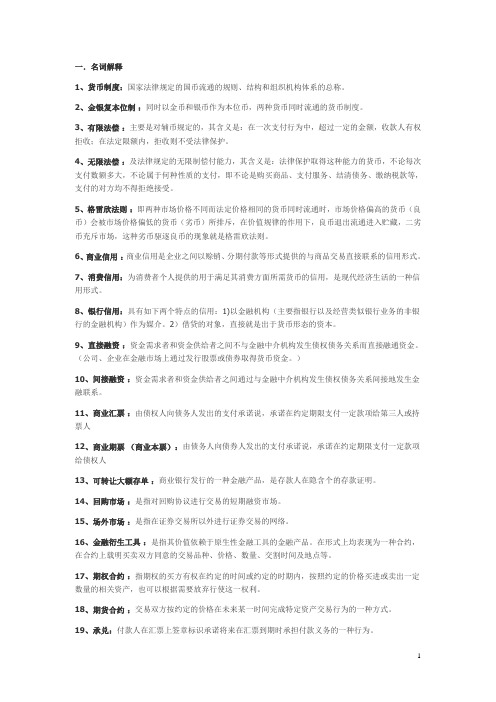
一.名词解释1、货币制度:国家法律规定的国币流通的规则、结构和组织机构体系的总称。
2、金银复本位制:同时以金币和银币作为本位币,两种货币同时流通的货币制度。
3、有限法偿:主要是对辅币规定的,其含义是:在一次支付行为中,超过一定的金额,收款人有权拒收;在法定限额内,拒收则不受法律保护。
4、无限法偿:及法律规定的无限制偿付能力,其含义是:法律保护取得这种能力的货币,不论每次支付数额多大,不论属于何种性质的支付,即不论是购买商品、支付服务、结清债务、缴纳税款等,支付的对方均不得拒绝接受。
5、格雷欣法则:即两种市场价格不同而法定价格相同的货币同时流通时,市场价格偏高的货币(良币)会被市场价格偏低的货币(劣币)所排斥,在价值规律的作用下,良币退出流通进入贮藏,二劣币充斥市场,这种劣币驱逐良币的现象就是格雷欣法则。
6、商业信用:商业信用是企业之间以赊销、分期付款等形式提供的与商品交易直接联系的信用形式。
7、消费信用:为消费者个人提供的用于满足其消费方面所需货币的信用,是现代经济生活的一种信用形式。
8、银行信用:具有如下两个特点的信用:1)以金融机构(主要指银行以及经营类似银行业务的非银行的金融机构)作为媒介。
2)借贷的对象,直接就是出于货币形态的资本。
9、直接融资:资金需求者和资金供给者之间不与金融中介机构发生债权债务关系而直接融通资金。
(公司、企业在金融市场上通过发行股票或债券取得货币资金。
)10、间接融资:资金需求者和资金供给者之间通过与金融中介机构发生债权债务关系间接地发生金融联系。
11、商业汇票:由债权人向债务人发出的支付承诺说,承诺在约定期限支付一定款项给第三人或持票人12、商业期票(商业本票):由债务人向债券人发出的支付承诺说,承诺在约定期限支付一定款项给债权人13、可转让大额存单:商业银行发行的一种金融产品,是存款人在隐含个的存款证明。
14、回购市场:是指对回购协议进行交易的短期融资市场。
15、场外市场:是指在证券交易所以外进行证券交易的网络。
2022年浙江财经大学专业课《金融学》科目期末试卷B(有答案)
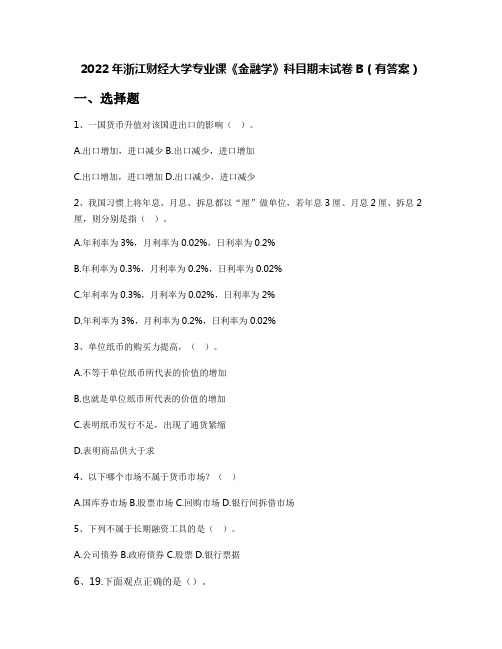
2022年浙江财经大学专业课《金融学》科目期末试卷B(有答案)一、选择题1、一国货币升值对该国进出口的影响()。
A.出口增加,进口减少B.出口减少,进口增加C.出口增加,进口增加D.出口减少,进口减少2、我国习惯上将年息、月息、拆息都以“厘”做单位,若年息3厘、月息2厘、拆息2厘,则分别是指()。
A.年利率为3%,月利率为0.02%,日利率为0.2%B.年利率为0.3%,月利率为0.2%,日利率为0.02%C.年利率为0.3%,月利率为0.02%,日利率为2%D.年利率为3%,月利率为0.2%,日利率为0.02%3、单位纸币的购买力提高,()。
A.不等于单位纸币所代表的价值的增加B.也就是单位纸币所代表的价值的增加C.表明纸币发行不足,出现了通货紧缩D.表明商品供大于求4、以下哪个市场不属于货币市场?()A.国库券市场B.股票市场C.回购市场D.银行间拆借市场5、下列不属于长期融资工具的是()。
A.公司债券B.政府债券C.股票D.银行票据6、19.下面观点正确的是()。
A.在通常情况下,资金时间价值是在既没有风险也没有通货膨胀条件下的社会平均利润率B.没有经营风险的企业也就没有财务风险;反之,没有财务风险的企业也就没有经营风险C.永续年金与其他年金一样,与递延期无关,所以计算方法和普通年金终值相同D.递延年金终值的大小,与递延期无关,所以计算方法和普通年金终值相同7、美式期权是指期权的执行时间()。
A.只能在到期日B.可以在到期日之前的任何时候C.可以在到期日或到期日之前的任何时候D.不能随意改变8、持有货币的机会成本是()。
A.汇率B.流通速度C.名义利率D.实际利率9、个人获得住房贷款属于()。
A.商业信用B.消费信用C.国家信用D.补偿贸易10、以下的金融资产中不具有与期权类似的特征的是()。
A.可转债B.信用期权C.可召回债券D. 期货11、优先股的收益率经常低于债券的收益率,原因是()。
浙江财经金融专硕-公司金融习题集 公司金融期末资料暂缺计算题
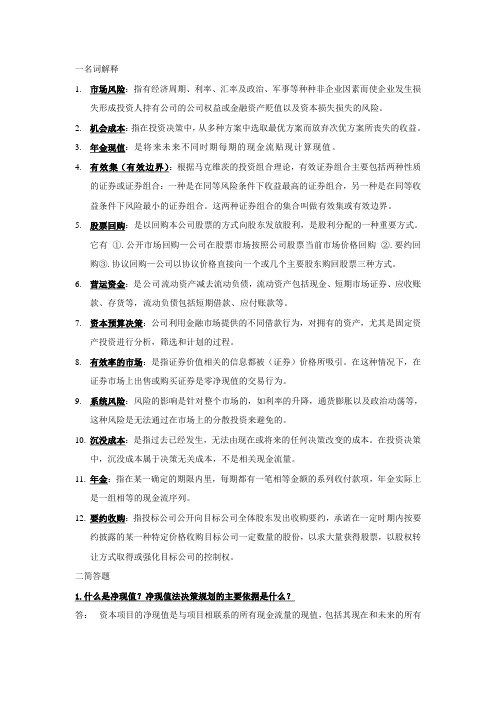
一名词解释1.市场风险:指有经济周期、利率、汇率及政治、军事等种种非企业因素而使企业发生损失形成投资人持有公司的公司权益或金融资产贬值以及资本损失损失的风险。
2.机会成本:指在投资决策中,从多种方案中选取最优方案而放弃次优方案所丧失的收益。
3.年金现值:是将来未来不同时期每期的现金流贴现计算现值。
4.有效集(有效边界):根据马克维茨的投资组合理论,有效证券组合主要包括两种性质的证券或证券组合:一种是在同等风险条件下收益最高的证券组合,另一种是在同等收益条件下风险最小的证券组合。
这两种证券组合的集合叫做有效集或有效边界。
5.股票回购:是以回购本公司股票的方式向股东发放股利,是股利分配的一种重要方式。
它有①.公开市场回购—公司在股票市场按照公司股票当前市场价格回购②.要约回购③.协议回购—公司以协议价格直接向一个或几个主要股东购回股票三种方式。
6.营运资金:是公司流动资产减去流动负债,流动资产包括现金、短期市场证券、应收账款、存货等,流动负债包括短期借款、应付账款等。
7.资本预算决策:公司利用金融市场提供的不同借款行为,对拥有的资产,尤其是固定资产投资进行分析,筛选和计划的过程。
8.有效率的市场:是指证券价值相关的信息都被(证券)价格所吸引。
在这种情况下,在证券市场上出售或购买证券是零净现值的交易行为。
9.系统风险:风险的影响是针对整个市场的,如利率的升降,通货膨胀以及政治动荡等,这种风险是无法通过在市场上的分散投资来避免的。
10.沉没成本:是指过去已经发生,无法由现在或将来的任何决策改变的成本。
在投资决策中,沉没成本属于决策无关成本,不是相关现金流量。
11.年金:指在某一确定的期限内里,每期都有一笔相等金额的系列收付款项,年金实际上是一组相等的现金流序列。
12.要约收购:指投标公司公开向目标公司全体股东发出收购要约,承诺在一定时期内按要约披露的某一种特定价格收购目标公司一定数量的股份,以求大量获得股票,以股权转让方式取得或强化目标公司的控制权。
金融学期末—浙财经

《货币银行学复习思考题》一、名词解释:货币制度铸币税金银复本位制金本位制无限法偿格雷欣法则商业信用消费信用银行信用直接融资间接融资商业汇票商业期票(商业本票)可转让大额存单回购市场场外市场金融衍生工具期权合约期货合约承兑票据贴现政策性银行商业银行负债业务商业银行资产业务商业银行中间业务表外业务基准利率回购协议货币需求流动性陷阱基础货币货币供给货币乘数派生存款菲利普斯曲线公开市场操作货币政策传导机制二、简答:1.简要比较商业信用与银行信用。
2.信用的三要素及主要形式有哪些?3.简要分析金融市场的功能4.货币市场主要有哪些子市场?5.简述关于利率决定的可贷资金理论。
6.简述凯恩斯流动性偏好利率理论。
7.决定和影响利率的主要因素有哪些?8.什么商业银行的中间业务?主要有哪些?9.简述我国商业银行的性质和体系。
10.简述商业银行的主要负债业务和资产业务。
11.简述中央银行的资产负债业务12.简述中央银行的职能。
13.简述费雪的现金交易理论的主要内容。
14.简述剑桥学派的现金余额说理论的主要内容。
15.简述弗里德曼的货币需求理论(现代货币数量论)16.试比较凯恩斯和弗里德曼的货币需求理论。
17.简述我国货币供给层次的具体内容。
18.简述商业银行创造存款货币的机制,并分析制约商业银行创造派生存款的能力的因素。
19.货币供给层次的划分标准和内容构成是什么。
20.简要叙述托宾的货币政策传导机制理论的基本思想(托宾的Q理论)。
21.简述主要的货币政策中介目标及其选择的标准。
22.何谓中央银行的公开市场业务?并简述其优缺点。
三、论述1.试论金融市场的主要功能。
2.为何有了直接融资市场(比如债券市场和股票市场),还需要银行类金融中介机构来从事间接融资。
3.试比较实际利率理论、凯恩斯的利率理论和可贷资金利率理论。
4.分析利率变动对投资和储蓄的理论影响效应,结合实际分析有哪些因素可能制约这些理论效应的发挥。
5.阐述货币供给的形成机制。
浙江财经大学公司金融期末复习

Problem:1.Function of financial market and list some financial intermediarie Answer1:A.contributing to higher production and efficiency in the economyB.Improving the well-being of consumers by allowing them to their purchases better Answer2:(1) facilitate investment and financing.(2) a reasonable guidance of capital flow, which contributes to the concentration of capital and promotes the transfer of high-efficiency units.(3) convenient and flexible turnover of funds.(4) to achieve risk diversification, reduce transaction costs.(5) are conducive to enhancing the flexibility of macro-control.(6) to help strengthen economic ties between regions and countries. Intermediaries:BanksBuilding societiesCredit unionsFinancial advisers or brokersInsurance companiesCollective investment schemesPension fundsThe investment decision is the most important of the firm’s three major decisions when it comes to value creation. It begins with a determination of the total amount of assets needed to be held by firm.Financing decision: financial manager is concerned with the makeup of the right-hand side of the balance sheet.Asset management decision: once assets have been acquired and appropriate financing provided, these assets must still be managed efficiently.2.Why profit maximization is not an ideal corporate finance objective?(1)The primary goal of corporate finance is maximize or increase shareholder value not profit(2)To a skilled accountant, however, a decision that increases profits under one set of accounting rules can reduce it under another.(3)Accounting profits are not necessarily the same as cash flows.(4)The problem with profit maximization as a goal is that it does not tell us when cash flows are to be received.(5)Profit maximization ignores the uncertainty or risk associated with cash flows. 总:For the fact that a firm cannot survive with mere profit maximization ,but must increase long-term security through investment and meeting shareholder expectations. This will increase their productive capacity for the future as well as encourage the risky capital investment of the shareholders.3. Characteristics of business organization:(1) sole proprietorship: A business owned and managed by a single individual.Features: Cheapest to form. no formal charter, few government regulationsPays no corporate income taxesUnlimited liability for business debts and obligations.Its life is limited by the life of the sole proprietorThe money raised is limited by the proprietor’s personal wealth(2) partnership: A business formed by two or more individuals or entities. General partnership: All partners share in gains or losses, all have unlimited liability for all partnership debts.Limited partnership: One or more general partners will run the business and have unlimited liability. The limited partner's liability is limited to their contribution to the partnership.Features: Often inexpensive and easy to formDifficult to transfer ownershipDifficult to raise large amounts of cashIncome is taxed as personal income(3) Corporation: Is a legal “person” separate and distinct from its owners . Features: Limited liability for stockholders.Unlimited life for the business.Ownership can be easily transferred.These characteristics make it easier for corporations to raise capital. The disadvantage to corporations is double taxation.4. What is corporate finance and describe their decisions?Corporate finance is the study of the answers to the following questions:(1) What long-term investments should you take on?(2)Where will you get the long-term financing to pay for your investment?(3) How will you manage your everyday financial activities?(WIKI)Corporate finance is the area of finance dealing with the sources of funding and the capital structure of corporations and the actions that managers take to increase the value of the firm to the shareholders, as well as the tools and analysis used to allocate financial resources.Investment Decisions: Concerning non-current assent or capital budgeting.Evaluating the size, timing and risk of future cash flow.Cash flow versus accounting profitFinancing Decisions: Determine how the assets will be financed.What is the best type of financing?What is the best financing mix?What is the best dividend policy (dividend decision)?Capital structureAsset Management Decisions: How do we manage existing assets efficiently?Greater emphasis on current asset management than fixed assetmanagement.Working capital management.5. Evaluate IRR ruleFor the fact that internal rate of return is a rate quantity, it always is used to be an excellent indicator of the efficiency, quality, or yield of an investment. However, As an investment decision tool, the calculated IRR should not be used to rate mutually exclusive projects, but only to decide whether a single project is worth investing in.The IRR does give you a rate of return, but the IRR could be for a small investment or for only a short period of time.6. Financial managementFinancial management is concerned with the acquisition, financing, and management of assets with some overall goal in mind.The investment decision is the most important of the firm’s three major decisions when it comes to value creation. It begins with a determination of the total amount of assets needed to be held by firm.Financing decision: financial manager is concerned with the makeup of the right-hand side of the balance sheet.Asset management decision: once assets have been acquired and appropriate financing provided, these assets must still be managed efficiently.7. Describe net operation theory,traditional theory, MM theory without(with)corporate tax, with bankruptcy and agency costNet Operating Income Approach -- A theory of capital structure in which the weighted average cost of capital and the total value of the firm remain constant as financial leverage is changed.Traditional Approach -- A theory of capital structure in which there exists an optimal capital structure and where management can increase the total value of the firm through the judicious use of financial leverage.The relationship between financial leverage and the cost of capital is explained by the NOI approach.Provide behavioral justification for a constant ko over the entire range of financial leverage possibilities.Total risk for all security holders of the firm is not altered by the capital structure.Therefore, the total value of the firm is not altered by the firm’s financing mix. Total market value is not altered by the capital structure (the total size of the pies are the same).M&M assume an absence of taxes and market imperfections.Investors can substitute personal for corporate financial leverage.No TaxesProposition I: Firm value is not affected by leverageVL = VUProposition II: Leverage increases the risk and return to stockholdersrs = r0 + (B / SL) (r0 - rB)rB is the interest rate (cost of debt)rs is the return on (levered) equity (cost of equity)r0 is the return on unlevered equity (cost of capital)B is the value of debtSL is the value of levered equitywith Corporate TaxesProposition I (with Corporate Taxes):Firm value increases with leverage VL = VU + TC BProposition II (with Corporate Taxes):Some of the increase in equity risk and return is offset by interest tax shield rS = r0 + (B/S)×(1-TC)×(r0 - rB)rB is the interest rate (cost of debt)rS is the return on equity (cost of equity)r0 is the return on unlevered equity (cost of capital)B is the value of debtS is the value of levered equityAgency Costs -- Costs associated with monitoring management to ensure that it behaves in ways consistent with the firm’s contractual agreements with creditors and shareholders.Value of levered firm= Value of firm if unlevered + Present value of tax-shield benefits of debt -Present value of bankruptcy and agency costsCalculation:1.Annuity;Perpetuity:PV:FVC = Cash flow per periodi = interest raten = number of paymentsC = Cash flow per periodi = interest raten = number of paymentsPV of a perpetuity = P / iIn this formula "P" represents your annual payment and "i" represents your interest or discount rate.PV of a growing perpetuity = P / (i - g)In this formula "P" represents your annual payment, "i" represents your interest or discount rate and "g" represents the growth rate.2.Valuation of bond(half year)and stock3.Investment criterion IRR,NPV,PBP,PINPV:Given the (period, cash flow) pairs (, ) where is the total number of periods, the net present value is given by:IRR:NPV=0,i=IRRGiven the (period, cash flow) pairs (, ) where is the total number of periods, the net present value is given by:PBP:Payback Period = W + (X - Y) / ZW is the year before which the investment value is crossed in cumulative cash flows X is the initial investment or the initial cash outlayY is the cumulative cash flow just before the investment value is crossed in cumulative cash flowsZ is the cash flow of the year in which the investment value is crossed in the cumulative cash flowsPI:PI=(PV of future cash flow )/(Initial investment)=1+NPV/(Initial investment)4.Expanding and Replacement:;EAC:EAC = NPV/A t, r where A= the present value of an annuity factort = number of periodsr = interest rateA t, r=(1-1/(1+r)^t)/r5.WACC,CAPM:WACC:where is the number of sources of capital (securities, types of liabilities); is the required rate of return for security ; and is the market value of all outstanding securities .where D is the total debt, E is the total shareholder’s equity, Ke is the cost of equity, and Kd is the cost of debt.Tax effects[edit]Tax effects can be incorporated into this formula. For example, the WACC for a company financed by one type of shares with the total market value of and cost of equity and one type of bonds with the total market value of and cost of debt , in a country with corporate tax rate , is calculated as:CAPM:where:is the expected return on the capital assetis the risk-free rate of interest such as interest arising from government bonds (the beta) is the sensitivity of the expected excess asset returns to the expected excess market returns, or also ,is the expected return of the marketis sometimes known as the market premium (the difference between the expected market rate of return and the risk-free rate of return).is also known as the risk premiumRestated, in terms of risk premium, we find that:Modified formula:"where:is required return on security iis risk-free rateis general market risk premiumis risk premium for small sizeis risk premium due to company-specific risk factor6.DOL,DFL,DTL,EPS-EBITDOL:DOL =% change in EBIT / % change in salesDFL:DFL =% change in EPS / % change in EBITDTL:DTL =% change in EPS / % change in salesEPS:earnings per shareEBIT:operating profit7.MM without and with corporate tax;arbitrageWithout taxesProposition Iwhereis the value of an unlevered firm = price of buying a firm composed only of equity, and is the value of a levered firm = price of buying a firm that is composedof some mix of debt and equity. Another word for levered is geared, which has the same meaning.Proposition IIwhereis the required rate of return on equity, or cost of equity.is the company unlevered cost of capital (ie assume no leverage).is the required rate of return on borrowings, or cost of debt.is the debt-to-equity ratio.With taxesProposition Iwhereis the value of a levered firm.is the value of an unlevered firm.is the tax rate () x the value of debt (D)the term assumes debt is perpetualProposition IIwhere:is the required rate of return on equity, or cost of levered equity = unlevered equity + financing premium.is the company cost of equity capital with no leverage (unlevered cost of equity, or return on assets with D/E = 0).is the required rate of return on borrowings, or cost of debt.is the debt-to-equity ratio.is the tax rate.。
浙江财经公司金融期末复习整理
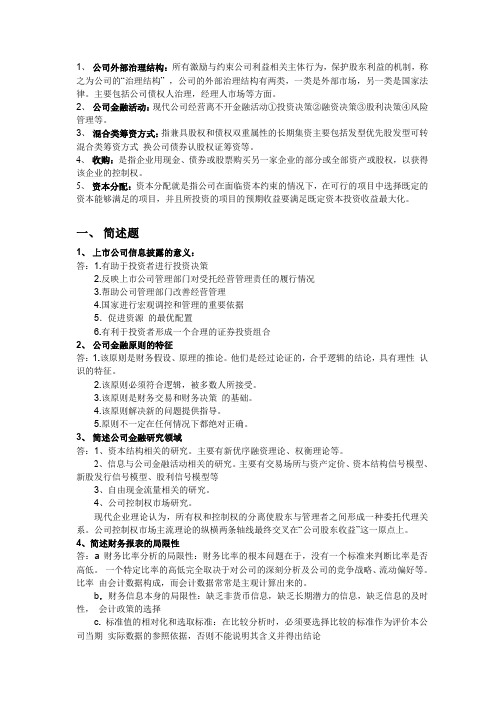
1、公司外部治理结构:所有激励与约束公司利益相关主体行为,保护股东利益的机制,称之为公司的“治理结构”,公司的外部治理结构有两类,一类是外部市场,另一类是国家法律。
主要包括公司债权人治理,经理人市场等方面。
2、公司金融活动:现代公司经营离不开金融活动①投资决策②融资决策③股利决策④风险管理等。
3、混合类筹资方式:指兼具股权和债权双重属性的长期集资主要包括发型优先股发型可转混合类筹资方式换公司债券认股权证筹资等。
4、收购:是指企业用现金、债券或股票购买另一家企业的部分或全部资产或股权,以获得该企业的控制权。
5、资本分配:资本分配就是指公司在面临资本约束的情况下,在可行的项目中选择既定的资本能够满足的项目,并且所投资的项目的预期收益要满足既定资本投资收益最大化。
一、简述题1、上市公司信息披露的意义:答:1.有助于投资者进行投资决策2.反映上市公司管理部门对受托经营管理责任的履行情况3.帮助公司管理部门改善经营管理4.国家进行宏观调控和管理的重要依据5.促进资源的最优配置6.有利于投资者形成一个合理的证券投资组合2、公司金融原则的特征答:1.该原则是财务假设、原理的推论。
他们是经过论证的,合乎逻辑的结论,具有理性认识的特征。
2.该原则必须符合逻辑,被多数人所接受。
3.该原则是财务交易和财务决策的基础。
4.该原则解决新的问题提供指导。
5.原则不一定在任何情况下都绝对正确。
3、简述公司金融研究领域答:1、资本结构相关的研究。
主要有新优序融资理论、权衡理论等。
2、信息与公司金融活动相关的研究。
主要有交易场所与资产定价、资本结构信号模型、新股发行信号模型、股利信号模型等3、自由现金流量相关的研究。
4、公司控制权市场研究。
现代企业理论认为,所有权和控制权的分离使股东与管理者之间形成一种委托代理关系。
公司控制权市场主流理论的纵横两条轴线最终交叉在“公司股东收益”这一原点上。
4、简述财务报表的局限性答:a 财务比率分析的局限性:财务比率的根本问题在于,没有一个标准来判断比率是否高低。
浙江财经金融专硕-《公司金融》(17级)复习内容
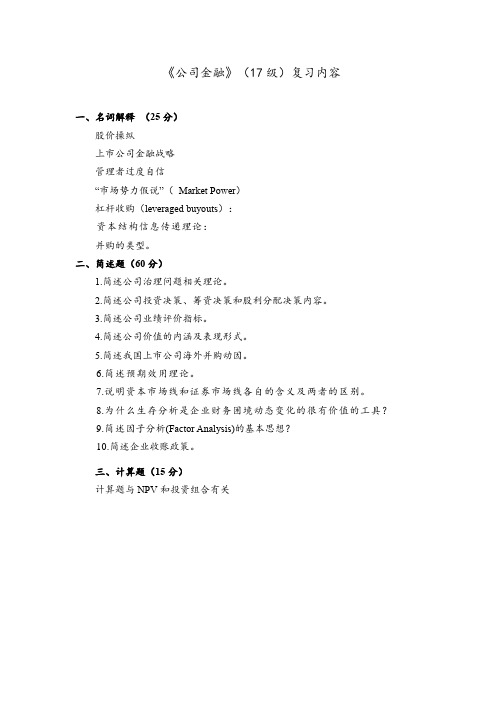
《公司金融》(17级)复习内容一、名词解释(25分)股价操纵上市公司金融战略管理者过度自信“市场势力假说”(Market Power)杠杆收购(leveraged buyouts):资本结构信息传递理论:并购的类型。
二、简述题(60分)1.简述公司治理问题相关理论。
2.简述公司投资决策、筹资决策和股利分配决策内容。
3.简述公司业绩评价指标。
4.简述公司价值的内涵及表现形式。
5.简述我国上市公司海外并购动因。
6.简述预期效用理论。
7.说明资本市场线和证券市场线各自的含义及两者的区别。
8.为什么生存分析是企业财务困境动态变化的很有价值的工具?9.简述因子分析(Factor Analysis)的基本思想?10.简述企业收账政策。
三、计算题(15分)计算题与NPV和投资组合有关一、名词解释(25分)股价操纵某些股票投资者通过显性或隐形的方式,避开监管机构,甚至是利用法律的漏洞,达到对股票价格的可持续控制,其目的就是获得不正当利益。
操纵股价不一定是机构,也可能是公司内部管理人员、大股东、隐形股东、个人等,只要集中资金优势、内部信息优势、管理优势等,其他投资不具备的特殊条件,达到使股票价格可持续的改变,为自己获得不正当的巨额利润的行为均属于操纵股价。
上市公司金融战略金融战略是指如何用金融杠杆,连锁、加盟、融资、股权打造“财富帝国”、上市公司的整个策划方案。
管理者过度自信一般认为,所谓管理者过度自信是指管理者在进行决策时会因为高估自身的能力和知识而产生偏差,从而导致管理者高估决策成功的可能性并低估与决策相关的风险“市场势力假说”(Market Power)市场势力理论是一种市场理论,该理论认为,并购活动的主要动因经常是由于可以借并购达到减少竞争对手来增强对经营环境的控制,提高市场占有率,使企业获得某种形式的垄断或寡占利润,并增加长期的获利机会。
杠杆收购(leveraged buyouts):书P338资本结构信息传递理论:信号传递理论认为,公司可以通过调整资本结构来传递有关获利能力和风险方面的信息,以及公司如何看待股票市价的信息。
- 1、下载文档前请自行甄别文档内容的完整性,平台不提供额外的编辑、内容补充、找答案等附加服务。
- 2、"仅部分预览"的文档,不可在线预览部分如存在完整性等问题,可反馈申请退款(可完整预览的文档不适用该条件!)。
- 3、如文档侵犯您的权益,请联系客服反馈,我们会尽快为您处理(人工客服工作时间:9:00-18:30)。
Problem:1.Function of financial market and list some financial intermediarieAnswer1:A.contributing to higher production and efficiency in the economyB.Improving the well-being of consumers by allowing them to their purchases betterAnswer2:(1) facilitate investment and financing.(2) a reasonable guidance of capital flow, which contributes to the concentration of capital and promotes the transfer of high-efficiency units.(3) convenient and flexible turnover of funds.(4) to achieve risk diversification, reduce transaction costs.(5) are conducive to enhancing the flexibility of macro-control.(6) to help strengthen economic ties between regions and countries.Intermediaries:BanksBuilding societiesCredit unionsFinancial advisers or brokersInsurance companiesCollective investment schemesPension fundsThe investment decision is the most important of the firm’s three major decisions when it comes to value creation. It begins with a determination of the total amount of assets needed to be held by firm.Financing decision: financial manager is concerned with the makeup of the right-hand side of the balance sheet.Asset management decision: once assets have been acquired and appropriate financing provided, these assets must still be managed efficiently.2.Why profit maximization is not an ideal corporate finance objective?(1)The primary goal of corporate finance is maximize or increase shareholder value not profit(2)To a skilled accountant, however, a decision that increases profits under one set of accounting rules can reduce it under another.(3)Accounting profits are not necessarily the same as cash flows.(4)The problem with profit maximization as a goal is that it does not tell us when cash flows are to be received.(5)Profit maximization ignores the uncertainty or risk associated with cash flows.总:For the fact that a firm cannot survive with mere profit maximization ,but must increase long-term security through investment and meeting shareholder expectations. This will increase their productive capacity for the future as well as encourage the risky capital investment of the shareholders.3. Characteristics of business organization:(1) sole proprietorship: A business owned and managed by a single individual.Features: Cheapest to form. no formal charter, few government regulationsPays no corporate income taxesUnlimited liability for business debts and obligations.Its life is limited by the life of the sole proprietorThe money raised is limited by the proprietor’s personal wealth(2) partnership: A business formed by two or more individuals or entities.General partnership: All partners share in gains or losses, all have unlimited liability for all partnership debts.Limited partnership: One or more general partners will run the business and have unlimited liability. The limited partner's liability is limited to their contribution to the partnership. Features: Often inexpensive and easy to formDifficult to transfer ownershipDifficult to raise large amounts of cashIncome is taxed as personal income(3) Corporation: Is a legal “person”separate and distinct from its owners .Features: Limited liability for stockholders.Unlimited life for the business.Ownership can be easily transferred.These characteristics make it easier for corporations to raise capital.The disadvantage to corporations is double taxation.4. What is corporate finance and describe their decisions?Corporate finance is the study of the answers to the following questions:(1) What long-term investments should you take on?(2)Where will you get the long-term financing to pay for your investment?(3) How will you manage your everyday financial activities?(WIKI)Corporate finance is the area of finance dealing with the sources of funding and the capital structure of corporations and the actions that managers take to increase the value of the firm to the shareholders, as well as the tools and analysis used to allocate financial resources.Investment Decisions: Concerning non-current assent or capital budgeting.Evaluating the size, timing and risk of future cash flow.Cash flow versus accounting profitFinancing Decisions: Determine how the assets will be financed.What is the best type of financing?What is the best financing mix?What is the best dividend policy (dividend decision)?Capital structureAsset Management Decisions: How do we manage existing assets efficiently?Greater emphasis on current asset management than fixed assetmanagement.Working capital management.5. Evaluate IRR ruleFor the fact that internal rate of return is a rate quantity, it always is used to be an excellent indicator of the efficiency, quality, or yield of an investment.However, As an investment decision tool, the calculated IRR should not be used to rate mutually exclusive projects, but only to decide whether a single project is worth investing in.The IRR does give you a rate of return, but the IRR could be for a small investment or for only a short period of time.6. Financial managementFinancial management is concerned with the acquisition, financing, and management of assets with some overall goal in mind.The investment decision is the most important of the firm’s three major decisions when it comes to value creation. It begins with a determination of the total amount of assets needed to be held by firm.Financing decision: financial manager is concerned with the makeup of the right-hand side of the balance sheet.Asset management decision: once assets have been acquired and appropriate financing provided, these assets must still be managed efficiently.7. Describe net operation theory,traditional theory, MM theory without(with)corporate tax, with bankruptcy and agency costNet Operating Income Approach -- A theory of capital structure in which the weighted average cost of capital and the total value of the firm remain constant as financial leverage is changed. Traditional Approach -- A theory of capital structure in which there exists an optimal capital structure and where management can increase the total value of the firm through the judicious use of financial leverage.The relationship between financial leverage and the cost of capital is explained by the NOI approach.Provide behavioral justification for a constant ko over the entire range of financial leverage possibilities.Total risk for all security holders of the firm is not altered by the capital structure.Therefore, the total value of the firm is not altered by the firm’s financing mix.Total market value is not altered by the capital structure (the total size of the pies are the same).M&M assume an absence of taxes and market imperfections.Investors can substitute personal for corporate financial leverage.No TaxesProposition I: Firm value is not affected by leverageVL = VUProposition II: Leverage increases the risk and return to stockholdersrs = r0 + (B / SL) (r0 - rB)rB is the interest rate (cost of debt)rs is the return on (levered) equity (cost of equity)r0 is the return on unlevered equity (cost of capital)B is the value of debtSL is the value of levered equitywith Corporate TaxesProposition I (with Corporate Taxes):Firm value increases with leverage VL = VU + TC BProposition II (with Corporate Taxes):Some of the increase in equity risk and return is offset by interest tax shield rS = r0 + (B/S)×(1-TC)×(r0 - rB)rB is the interest rate (cost of debt)rS is the return on equity (cost of equity)r0 is the return on unlevered equity (cost of capital)B is the value of debtS is the value of levered equityAgency Costs -- Costs associated with monitoring management to ensure that it behaves in ways consistent with the firm’s contractual agreements with creditors and shareholders.Value of levered firm= Value of firm if unlevered + Present value of tax-shield benefits of debt -Present value of bankruptcy and agency costsCalculation:1.Annuity;Perpetuity:PV:FVC = Cash flow per periodi = interest raten = number of paymentsC = Cash flow per periodi = interest raten = number of paymentsPV of a perpetuity = P / iIn this formula "P" represents your annual payment and "i" represents your interest or discount rate. PV of a growing perpetuity = P / (i - g)In this formula "P" represents your annual payment, "i" represents your interest or discount rate and "g" represents the growth rate.2.Valuation of bond(half year)and stock3.Investment criterion IRR,NPV,PBP,PINPV:Given the (period, cash flow) pairs (, ) where is the total number of periods, the net present value is given by:IRR:NPV=0,i=IRRGiven the (period, cash flow) pairs (, ) where is the total number of periods, the net present value is given by:PBP:Payback Period = W + (X - Y) / ZW is the year before which the investment value is crossed in cumulative cash flowsX is the initial investment or the initial cash outlayY is the cumulative cash flow just before the investment value is crossed in cumulative cash flows Z is the cash flow of the year in which the investment value is crossed in the cumulative cash flowsPI:PI=(PV of future cash flow )/(Initial investment)=1+NPV/(Initial investment)4.Expanding and Replacement:;EAC:EAC = NPV/A t, r where A= the present value of an annuity factort = number of periodsr = interest rateA t, r=(1-1/(1+r)^t)/r5.WACC,CAPM:WACC:where is the number of sources of capital (securities, types of liabilities); is the required rate of return for security ; and is the market value of all outstanding securities .where D is t he total debt, E is the total shareholder’s equity, Ke is the cost of equity, and Kd is the cost of debt.Tax effects[edit]Tax effects can be incorporated into this formula. For example, the WACC for a company financed by one type of shares with the total market value of and cost of equity and one type of bonds with the total market value of and cost of debt , in a country with corporate tax rate , is calculated as:CAPM:where:is the expected return on the capital assetis the risk-free rate of interest such as interest arising from government bonds(the beta) is the sensitivity of the expected excess asset returns to the expected excess marketreturns, or also ,is the expected return of the marketis sometimes known as the market premium (the difference between the expected market rate of return and the risk-free rate of return).is also known as the risk premiumRestated, in terms of risk premium, we find that:Modified formula:"where:is required return on security iis risk-free rateis general market risk premiumis risk premium for small sizeis risk premium due to company-specific risk factor6.DOL,DFL,DTL,EPS-EBITDOL:DOL =% change in EBIT / % change in salesDFL:DFL =% change in EPS / % change in EBITDTL:DTL =% change in EPS / % change in salesEPS:earnings per shareEBIT:operating profit7.MM without and with corporate tax;arbitrageWithout taxesProposition Iwhereis the value of an unlevered firm = price of buying a firm composed only of equity, andis the value of a levered firm = price of buying a firm that is composed of some mix of debt and equity. Another word for levered is geared, which has the same meaning.Proposition IIwhereis the required rate of return on equity, or cost of equity.is the company unlevered cost of capital (ie assume no leverage).is the required rate of return on borrowings, or cost of debt.is the debt-to-equity ratio.With taxesProposition Iwhereis the value of a levered firm.is the value of an unlevered firm.is the tax rate () x the value of debt (D)the term assumes debt is perpetualProposition IIwhere:is the required rate of return on equity, or cost of levered equity = unlevered equity + financing premium.is the company cost of equity capital with no leverage (unlevered cost of equity, or return on assets with D/E = 0).is the required rate of return on borrowings, or cost of debt.is the debt-to-equity ratio.is the tax rate.。
